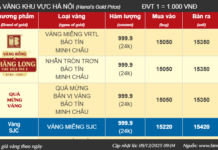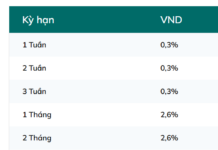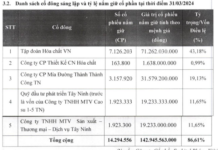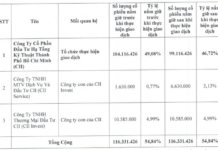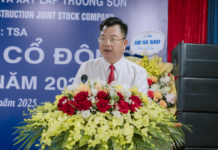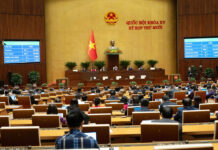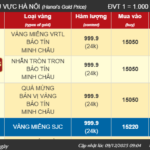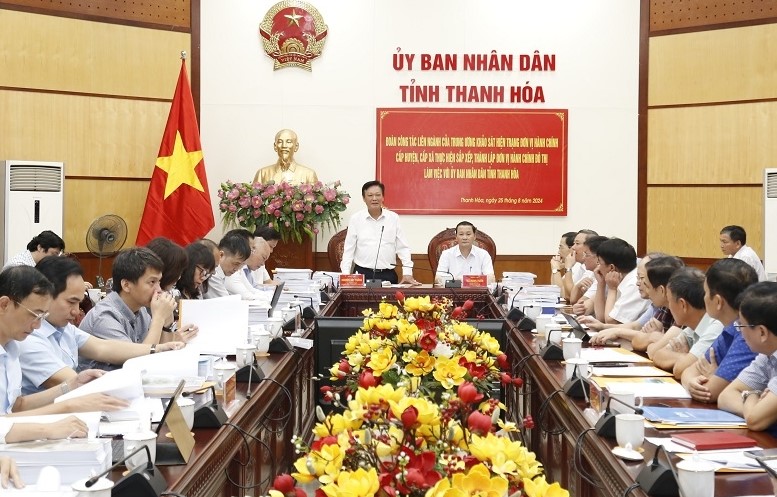
On August 25, a joint working group from the Central Government, led by Mr. Nguyen Duy Thang, Deputy Minister of Home Affairs, worked with the People’s Committee of Thanh Hoa province to survey the implementation of the Scheme on arranging administrative units at the district and communal levels for the period of 2023-2025 in Thanh Hoa province.
The working session focused on key tasks, including surveying the implementation of the Scheme on arranging administrative units at the district and communal levels for the 2023-2025 period in Thanh Hoa province; merging Dong Son district into Thanh Hoa city and establishing new wards in Thanh Hoa city; and establishing Ha Long and Ha Linh towns in Ha Trung district, Thanh Hoa province.
Regarding the Scheme on arranging administrative units at the district and communal levels in the 2023-2025 period, Thanh Hoa province will rearrange 21 units (19 communes and 2 wards), including 18 units subject to rearrangement and 3 adjacent units, in localities such as Sam Son city, Nghi Son town, Nga Son district, Hau Loc district, and Hoang Hoa district.
There are 128 units (123 communes and 5 wards) subject to rearrangement but with specific characteristics, thus requesting a delay in implementation. Four units are proposed to be established as wards, and two units are suggested to become towns.
For example, in Sam Son city, Dai Hung commune will be established by merging the entire 2.11 km2 of natural area and 7,054 people of Quang Dai commune with the entire 3.94 km2 of natural area and 7,241 people of Quang Hung commune.
In Nghi Son town, Hai Yen commune will be dissolved, and its natural area and population will be adjusted into the wards of Mai Lam, Tinh Hai, Hai Thuong, and Nguyen Binh. The natural area of Tinh Hai ward will be adjusted into Mai Lam ward.
Concerning the Scheme on merging Dong Son district into Thanh Hoa city and establishing new wards in Thanh Hoa city, the entire 82.87 km2 of natural area and 101,272 people of Dong Son district will be integrated into Thanh Hoa city.
Post-merger, Thanh Hoa city will cover a natural area of 228.22 km2 and have a population of 615,106 people, comprising 47 administrative units, including 33 wards and 14 communes.
Additionally, Thanh Hoa city will establish Rung Thong ward based on the entire 5.96 km2 of natural area and 11,918 people of Rung Thong town. Dong Thinh ward will be formed from the entire 4.38 km2 of natural area and 7,630 people of Dong Thinh commune. Hoằng Quang ward will be established with the entire 6.30 km2 of natural area and 8,954 people of Hoằng Quang commune. Hoằng Dai ward will be founded on the entire 4.67 km2 of natural area and 7,491 people of Hoằng Dai commune.
Ha Trung district will carry out the policy on arranging administrative units by establishing Ha Long town on the basis of the entire 48.41 km2 of natural area and 10,969 people of Ha Long commune. Ha Linh town will be formed from the entire 24.09 km2 of natural area and 10,031 people of Ha Linh commune.
Consequently, after implementing the policy on arranging administrative units at the district and communal levels for the 2023-2025 period, Thanh Hoa province will have 26 administrative units at the district level, including 22 districts, two towns, and two cities (a reduction of one district). There will be 547 administrative units at the communal level, comprising 452 communes, 63 wards, and 32 towns (a reduction of 11 units, including a decrease of 15 communes and an increase of three wards and one town).
During the working session, members of the joint working group from the Central Government provided suggestions and recommendations and requested clarification from the provincial authorities on various aspects. These included the conditions, standards, impacts, and implications of the merger and rearrangement of administrative units, as well as the establishment of wards and towns, on the local people and socio-economic development.
They also offered advice on rearranging redundant officials and public assets after the merger and requested clarification on the specific characteristics of the communal-level administrative units subject to rearrangement but with a request for delayed implementation. Additionally, they emphasized the need to ensure compliance with the criteria for establishing wards and towns.
Speaking at the working session, Mr. Do Minh Tuan, Chairman of the People’s Committee of Thanh Hoa province, expressed his appreciation for the valuable contributions and suggestions from the members of the joint working group. He assured them that their feedback would be carefully considered and incorporated into the implementation of the policy on arranging administrative units in Thanh Hoa province.
Based on the feedback received, Chairman Do Minh Tuan instructed the relevant authorities to promptly finalize the proposal, ensuring brevity, clarity, and compliance with legal regulations and practical requirements.
Chairman Do Minh Tuan emphasized the province’s determination and resolute leadership in implementing the policy on arranging administrative units within the province. He also expressed his hope for continued support and facilitation from the Central Government ministries and sectors regarding the implementation of this policy and the province’s urbanization process in the future.
In his conclusion, Deputy Minister Nguyen Duy Thang acknowledged the efforts of Thanh Hoa province in carrying out the policy on arranging administrative units for the 2023-2025 period. He requested the province to focus intently on completing and refining the proposal before submitting it to the Government and the National Assembly for approval.
Deputy Minister Nguyen Duy Thang emphasized the importance of ensuring consistent data and information in the proposal. He also highlighted that the establishment of new wards and towns should align with the local socio-economic development and planning.
Prior to the working session, on the afternoon of August 24, the joint working group from the Central Government conducted a field survey in Ha Long and Ha Linh communes of Ha Trung district and several communes of Dong Son district.
Thanh Hóa’s Foreign Affairs: Boosting Investment, Commerce, and Tourism
As part of the 2024 plan, the leaders of Thanh Hoa province will collaborate with international organizations, agencies, and businesses both within and outside the country to attract and promote investments. Additionally, the province will actively participate in major events to showcase and highlight the local potential and strengths in terms of investment, trade, and tourism…






